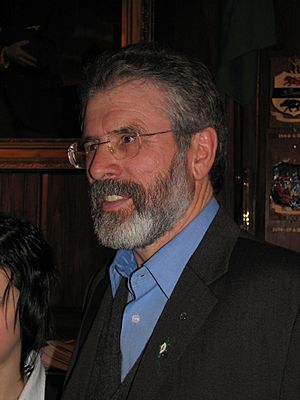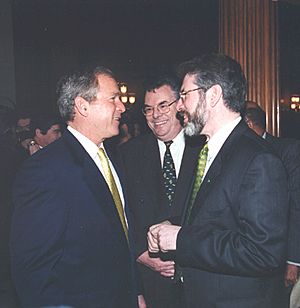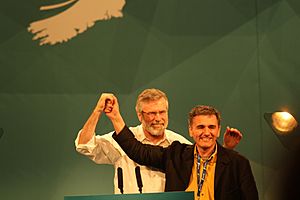Gerry Adams facts for kids
Quick facts for kids
Gerry Adams
|
|
|---|---|
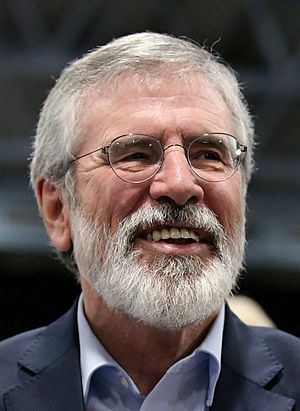
Adams in 2018
|
|
| President of Sinn Féin | |
| In office 13 November 1983 – 10 February 2018 |
|
| Vice President |
|
| Preceded by | Ruairí Ó Brádaigh |
| Succeeded by | Mary Lou McDonald |
| Leader of Sinn Féin in Dáil Éireann | |
| In office 9 March 2011 – 10 February 2018 |
|
| Preceded by | Caoimhghín Ó Caoláin |
| Succeeded by | Mary Lou McDonald |
| Teachta Dála for Louth |
|
| In office February 2011 – February 2020 |
|
| Member of the Legislative Assembly for Belfast West |
|
| In office 25 June 1998 – 7 December 2010 |
|
| Preceded by | Constituency established |
| Succeeded by | Pat Sheehan |
| Member of Parliament for Belfast West |
|
| In office 1 May 1997 – 26 January 2011 |
|
| Preceded by | Joe Hendron |
| Succeeded by | Paul Maskey |
| In office 9 June 1983 – 16 March 1992 |
|
| Preceded by | Gerry Fitt |
| Succeeded by | Joe Hendron |
| Personal details | |
| Born |
Gerard Adams
6 October 1948 Belfast, Northern Ireland |
| Political party | Sinn Féin |
| Spouse |
Collette McArdle
(m. 1971) |
| Children | 1 |
| Parent |
|
| Education | St. Mary's CBS, Belfast |
Gerard Adams (born 6 October 1948) is a retired politician from Ireland. He was the leader of the political party Sinn Féin for many years, from 1983 to 2018. He also served as a member of the Irish Parliament, called a Teachta Dála (TD), representing the area of Louth from 2011 to 2020.
Before that, he was a Member of Parliament (MP) in the UK Parliament for Belfast West. He held this role from 1983 to 1992 and again from 1997 to 2011. However, following Sinn Féin's policy, he did not take his seat in the UK Parliament.
Adams became involved in Irish politics in the late 1960s. He was a key figure in the Northern Ireland peace process from the late 1980s onwards. He had talks with other political leaders and with the Irish and British governments. In 1986, he helped Sinn Féin change its policy to allow members to take seats in the Irish Parliament. Later, in 1998, Sinn Féin also took seats in the power-sharing Northern Ireland Assembly.
Adams has often been accused of being involved with the Provisional Irish Republican Army (IRA) leadership in the 1970s and 1980s. He has always denied these claims. In 2014, he was questioned by police about a historical case but was released without any charges. In 2017, Adams announced he would step down as Sinn Féin leader in 2018. Mary Lou McDonald took over as leader on 10 February 2018.
Contents
Early Life and Education
Adams was born in Belfast, Northern Ireland, on 6 October 1948. His parents, Anne and Gerry Adams Sr., came from families with a history in Irish politics. His grandfather, also named Gerry Adams, was part of a group called the Irish Republican Brotherhood during the Irish War of Independence.
Adams went to St Finian's Primary School and then St Mary's Christian Brothers Grammar School. After finishing school, he worked in bars.
Starting in Politics
In the late 1960s, a movement for civil rights began in Northern Ireland. Adams became an active supporter and joined the Northern Ireland Civil Rights Association in 1967. This movement faced violence, and British troops were sent to Northern Ireland.
Adams became involved in the republican movement. In 1971, a policy called internment was brought back, allowing people to be held without trial. Adams was arrested in March 1972. He was later released briefly to take part in secret talks in London with the British government. He was arrested again in 1973 and held in Maze prison.
Rising in Sinn Féin
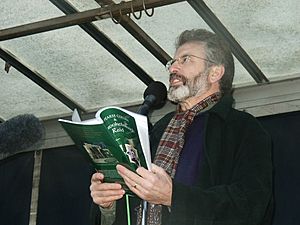
In 1978, Adams became a vice-president of Sinn Féin. He played a key role in changing the party's direction. He encouraged more political activity among republicans.
A major event was the 1981 Irish Hunger Strike by republican prisoners. One of the hunger strikers, Bobby Sands, was elected as an MP. This showed the power of political action. Adams was cautious at first, but these events led to Sinn Féin gaining more votes in elections.

In 1983, Adams was elected as an MP for Belfast West. He then became the president of Sinn Féin. He was the first Sinn Féin MP elected to the British House of Commons in many years.
Assassination Attempt
On 14 March 1984, Adams was seriously injured in an attack in Belfast. Gunmen from a group called the Ulster Defence Association (UDA) shot at his car. He was taken to the hospital and recovered. The attackers were caught by British soldiers.
Leading Sinn Féin
As leader, Adams helped Sinn Féin change from being mainly a voice for armed groups to a more organized political party.
For a long time, Sinn Féin had refused to take seats in the British or Irish parliaments. But at a meeting in 1986, Sinn Féin members voted to allow their elected representatives to sit in the Irish Parliament. This was a big change. A small group disagreed and left to form a different party.
Voice Ban
From 1988 to 1994, the British government put a ban on broadcasting the voices of certain political figures, including Adams. The idea was to stop them from getting publicity. A similar ban was in place in Ireland. However, TV and radio stations found ways around these bans. For example, actors would read out the words of the banned person while their video was shown. These bans were criticized and eventually lifted in 1994.
Moving into Mainstream Politics
Adams played a key role in the Northern Ireland peace process. He had secret talks with John Hume, the leader of another political party, the Social Democratic and Labour Party (SDLP). These talks helped lay the groundwork for the Belfast Agreement.
These discussions led to a ceasefire by the IRA in August 1994. After more talks, the Good Friday Agreement was signed in 1998. This agreement created new ways for people in Northern Ireland to share power and work together. As part of this agreement, Sinn Féin agreed to take seats in the new Northern Ireland Assembly.
Sinn Féin in Government
In March 2007, Adams was re-elected to the Northern Ireland Assembly. He met with Ian Paisley, the leader of the Democratic Unionist Party (DUP), for the first time. These meetings helped bring back the power-sharing government in Northern Ireland.
In January 2009, Adams attended the inauguration of US President Barack Obama.
Election to Irish Parliament
In May 2010, Adams was re-elected as an MP for West Belfast. However, he resigned his seat in December to run for election in the Irish Parliament (Dáil Éireann). In the 2011 Irish general election, he was elected as a TD for the area of Louth. He then became the leader of Sinn Féin in the Irish Parliament.
In December 2013, Adams was part of the Guard of Honour at Nelson Mandela's funeral.
Questioning by Police
On 30 April 2014, Adams was questioned by police in Northern Ireland about a historical case from 1972. He had arranged to be interviewed by the police and stated he had no involvement. After four days, he was released without any charges being brought against him. Adams criticized the timing of his arrest and repeated that he had no involvement in the case.
Later Years as President
In May 2015, Prince Charles shook Adams' hand during a visit to Ireland. This was seen as a very important moment of reconciliation.
In September 2017, Adams announced that he would step down as leader of Sinn Féin in 2018. He also said he would not run for re-election to the Irish Parliament in 2020.
End of Sinn Féin Leadership
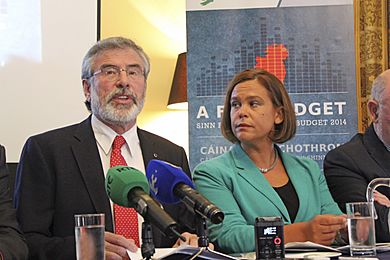
Adams' time as president of Sinn Féin ended on 10 February 2018. Mary Lou McDonald was elected as the party's new leader.
On 13 July 2018, a small homemade device was thrown at Adams' home in Belfast, damaging a car. Adams was not hurt. He suggested the attacks might be linked to recent events in Derry and asked those responsible to talk about their reasons.
BBC Case
In 2017, Adams started a legal case against the BBC over a TV program. The program suggested he had approved the killing of someone who was an informer. In May 2025, Adams won the case, and a jury decided the program was unfair to him.
Personal Life
In 1971, Adams married Collette McArdle. Their son, Gearoid, born in 1973, played Gaelic football for the Antrim GAA team.
Media Portrayals
Gerry Adams has been shown in several films and TV series:
- 2004 – The film Omagh, where he was played by actor Jonathan Ryan.
- 2010 – The TV film Mo, with actor John Lynch.
- 2016 – The film The Journey, with actor Ian Beattie.
- 2017 – The film The Foreigner, with actor Pierce Brosnan playing a character similar to Adams.
- 2024 – The TV series Say Nothing, where he was played by actors Josh Finan and Michael Colgan.
Published Works
Adams has written several books, including:
- Falls Memories, 1982
- The Politics of Irish Freedom, 1986
- A Pathway to Peace, 1988
- An Irish Voice: The Quest for Peace
- Cage Eleven, 1990
- The Street and Other Stories, 1993
- Free Ireland: Towards a Lasting Peace, 1995
- Before the Dawn: An Autobiography, 1996
- Selected Writings
- Who Fears to Speak...?, 2001
- An Irish Journal, 2001
- Hope and History: Making Peace in Ireland, 2003
- A Farther Shore, 2005
- The New Ireland: A Vision For The Future, 2005
- An Irish Eye, 2007
- My Little Book of Tweets, 2016
See also
 In Spanish: Gerry Adams para niños
In Spanish: Gerry Adams para niños


